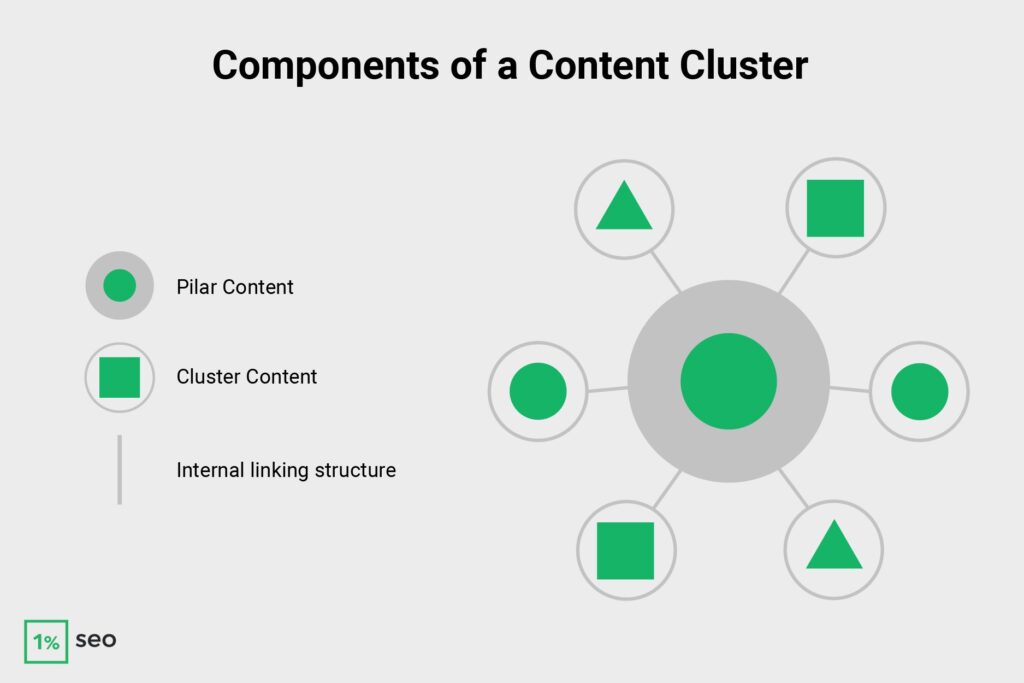In digital marketing, a revolutionary strategy transforms how content is created and organized online. Imagine a method that boosts your website’s visibility and enhances user engagement by providing a seamless, informative experience. This approach, known as a content cluster, is reshaping the landscape of search engine optimization (SEO). But what is a content cluster?
We will explore the fundamentals of content clustering and its potential benefits for SEO and user engagement. We will also dive into how businesses can implement this approach to strengthen their online presence.
Dive into this intriguing concept to uncover the secrets behind building a cohesive and authoritative content ecosystem that captivates search engines and your audience!

What Is a Content Cluster?
A content cluster organizes website information by linking related content around a central pillar topic. This central piece provides a comprehensive overview.
Surrounding it are smaller, detailed articles called cluster content, each focusing on specific aspects of the main topic. These pieces are interlinked, forming a cohesive web of information.
This approach emerged as search engines began understanding whole topics rather than individual keywords. Consequently, content creation shifted to focus on broader themes. Pillar and cluster content work together, enhancing comprehension for users and search engines.
The result is improved search rankings and easier access to related information for users. Content clusters help keep websites organized and ensure a clear, connected way of sharing information online.
Benefits of Content Clusters
Content clusters significantly enhance website performance and user experience by organizing related content around a main topic. This structure helps search engines recognize a site’s expertise, improving search rankings and attracting more visitors. As a result, users find the content relevant to their needs.
You will also benefit from easier navigation and access to comprehensive information, increasing your engagement and likelihood to return. Content clusters establish trust and authority, prompting other websites to link to your site and boosting visibility and credibility.
In several ways, content clusters make websites more successful. They help draw in visitors and keep them engaged once they arrive. Content clusters also reinforce the site’s reputation as a reliable information source.
Components of a Content Cluster
A content cluster has three main parts: pillar content, cluster content, and an internal linking structure. We elaborated more about them in the following:
Pillar content
Pillar content is a substantial and detailed piece that covers a broad topic comprehensively. This could be a long blog post or an extensive guide providing an overview of the entire subject. Typically, pillar content is lengthy, often exceeding 2,000 words, and addresses all the main points about the topic.
Good pillar content, known as evergreen content, remains useful over time. It is well-organized, features clear headings, and often includes helpful visuals like images or videos.
Additionally, pillar content links to more specific articles, known as cluster content, which delve deeper into subtopics. This interconnected structure aids both readers and search engines in navigating and understanding the subject.
Creating pillar content requires thorough research to ensure accuracy and depth. Ultimately, effective pillar content serves as a central resource that users return to and share, enhancing your site’s authority and visibility.
Cluster content
If pillar content is the foundation of your content strategy, think of cluster content as the rooms in a house. These smaller pieces focus on specific parts of the main topic, diving deep into one aspect of the subject. They can be shorter blog posts, videos, or infographics.
Although cluster content is more focused than pillar content, it still provides valuable information on its own. Good cluster content is easy to understand and often includes practical tips or examples.
Each piece also links back to the pillar content, creating a cohesive structure that enhances user experience and SEO. This interconnectedness allows users to explore related topics effortlessly, keeping them engaged longer.
That said, regularly updating cluster content ensures it remains relevant and useful. Maintaining high-quality cluster content establishes your site as a comprehensive resource on the topic.
Internal linking structure
The internal linking structure is like the hallways connecting the rooms in our house. It’s how all the content pieces link together. Each cluster content piece should link back to the pillar content. The pillar content, in turn, should link out to all the cluster content.
This network of links helps readers easily move between related topics. It also helps search engines understand how all your content fits together. This structure of pillar content, cluster content, and internal links creates a comprehensive resource on a topic.
It helps readers find the necessary information and shows search engines that your website is a knowledgeable source. By organizing content this way, websites can improve user experience and search engine rankings.

How to Create Topic Clusters
Creating topic clusters is a smart way to organize your website content. It helps both your readers and search engines understand your expertise. Here are the steps you should follow:
Identifying core topics
To build a successful topic cluster, start with a core topic that acts as your pillar content. This topic needs to be closely tied to your business, appeal to your audience, and be rich enough to branch into several subtopics. Then, analyze your business offerings, customer inquiries, and website data to pinpoint areas where you excel.
Your core topic should strike a balance: it must be specific to your niche but broad enough to accommodate multiple subtopics. This ensures that your content aligns with your business objectives and effectively showcases your expertise.
As you develop your cluster, it’s crucial to assess the competitive landscape. Identify content gaps and opportunities to distinguish yourself as a leading authority in your field.
Keyword research
Once you’ve identified your core topic, start by performing keyword research. This involves using tools like Google Keyword Planner, Semrush, or Ahrefs to discover your audience’s exact terms and phrases when searching for related information. Focus on keywords that strike a balance between search volume and competition.
Furthermore, long-tail keywords are especially valuable—they are specific and often used by users who are deeper into their decision-making process. Group these related keywords together to build clusters that will form the foundation of your content strategy.
Also, ensure these clusters align closely with your core topic and effectively address your audience’s search intent. Understanding their search intent is crucial for creating content that meets their needs.
Creating pillar content
After you’ve finished your core topic and keyword research, it’s time to create your pillar content. This will serve as the focal point of your topic cluster. Start by outlining all the main aspects of your topic. Use your keyword research to guide you, addressing the key points of interest.
To enhance credibility, aim for clarity using simple language. Organize your content with subheadings, bullets, and short paragraphs. Incorporate data, examples, and quotes from experts where applicable. You should also choose a format that aligns with your topic and audience—whether it’s a long-form blog post, a comprehensive guide, a landing page, or even a series of videos.
Moreover, follow SEO best practices throughout. Focus on delivering valuable information that meets the needs of your audience. Plan strategically where to link to future cluster content, ensuring a cohesive and interconnected structure. This approach boosts SEO and enhances the overall user experience by providing comprehensive and relevant information.
Developing cluster content
The next step is to create cluster content that delves deeper into specific subtopics related to your main topic. Start by identifying the most relevant and highly searched subtopics. These will form the foundation of your cluster content strategy.
Each piece of cluster content should provide detailed and valuable information on its subtopic. Ensure each piece is comprehensive enough to stand alone while connecting to the main pillar content.
When writing, integrate keyword research naturally to enhance SEO. Use practical examples, case studies, or data to enrich the content and provide practical insights for your readers.
Optimize your content with relevant keywords, meta descriptions, and image tags to improve search engine visibility. However, always prioritize creating user-focused and valuable content.
Lastly, maintain a strategic internal linking strategy. Connect your cluster content to the pillar content and other related pieces to guide readers through a cohesive journey of information discovery on your website.
Internal linking strategy
The final step in creating your topic cluster is implementing a robust internal linking strategy to connect all your content. Ensure every piece of cluster content links back to your pillar page using descriptive anchor text. Your pillar content should link to all cluster content, with updates as new content is created.
In addition, consider a content hub or index page to aid navigation and help search engines understand your structure. Link between different cluster content pieces where relevant, and regularly review and update links to maintain cohesiveness and value. We advise you to always prioritize user experience in your linking strategy.
A well-executed internal linking strategy enhances site navigation, improves SEO, and increases users’ time on your site. Ultimately, it creates a seamless and informative experience that encourages users to explore more of your content.

Common Mistakes to Avoid in Creating Content Clusters
Creating content clusters can be a powerful strategy for your website, but it’s easy to make mistakes. Here are the most common pitfalls and how to avoid them:
Lack of planning
One of the biggest mistakes you can make is diving into content creation without a solid plan. Before you start, it’s crucial to research what your audience wants to know. Skipping thorough keyword research can mean missing out on chances to rank well in search results.
To avoid these pitfalls, invest time in understanding your audience’s needs and interests. Tools such as Google Trends and keyword research platforms can help you identify relevant and popular topics. This groundwork forms the foundation for creating content that connects with your audience and performs strongly in search engine rankings.
Poor content quality
Another common issue is creating content without depth or value. This happens when you prioritize quantity over quality.
Your pillar content may end up shallow, lacking a comprehensive overview of the topic. Similarly, cluster content might just repeat what’s in the pillar instead of offering fresh insights.
To address this, invest time in crafting in-depth, valuable content. Ensure your pillar content covers all main aspects thoroughly. Then, let your cluster pieces delve into unique subtopics, adding depth and originality to your overall content strategy.
Ineffective linking strategy
A crucial part of content clusters is how the pieces link together, but this is where many creators stumble. Some overload their content with excessive internal links, which can overwhelm and confuse readers. On the other hand, some forget to link from pillar content to cluster content, disrupting the cluster’s structure.
To craft a successful linking strategy, prioritize strategic and sparing use of internal links. Focus on connecting content in a way that enhances relevance and clarity.
Also, remember to establish links in both directions: from pillar to cluster and from cluster to pillar. This approach ensures a cohesive and interconnected content structure that enhances user experience.
Ignoring user experience
Optimizing for search engines is important, but it’s equally crucial to consider the actual readers on your site. Complicated navigation can frustrate users, and text-heavy content may overwhelm and disengage them.
To enhance user experience, prioritize designing a clear, intuitive navigation system for your content cluster. Create a hub page or table of contents to help users easily find related content. Additionally, integrate relevant visual elements such as images, infographics, or videos to break up text and illustrate key points.
Neglecting content updates
A common mistake is treating content clusters as a “set it and forget it” project. Some creators never update their old content or expand their clusters with new topics, leading to outdated information and missed opportunities to cover emerging trends.
To keep your content clusters fresh and valuable, regularly review and update your existing content. Refresh statistics, examples, and information as your industry evolves. You should also continually research new subtopics and add cluster content to ensure your coverage remains comprehensive and authoritative.

Conclusion
As you have reached the very end, let’s sum up what is a content cluster. Content clusters offer a strategic way to organize website content, enhancing SEO and user engagement.
This approach improves search rankings by linking detailed subtopics to a central pillar topic, providing users with a seamless, informative experience. Regularly updating and expanding your content clusters ensures your website remains current, relevant, and authoritative.
So, embrace content clustering to transform your content marketing strategy and effectively attract and engage your audience. Start building your content clusters today and watch your online presence thrive!





